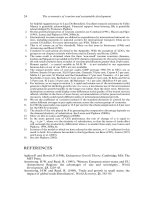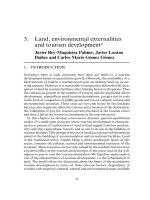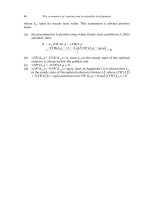THE ECONOMICS OF MONEY,BANKING, AND FINANCIAL MARKETS 561
Bạn đang xem bản rút gọn của tài liệu. Xem và tải ngay bản đầy đủ của tài liệu tại đây (35.24 KB, 1 trang )
CHAPTER 20
The International Financial System
529
The pegging of the yuan to the U.S. dollar has created several problems for
Chinese authorities. First, the Chinese now own a lot of U.S. assets, particularly U.S.
Treasury securities, which have very low returns. Second, the undervaluation of the
yuan has meant that Chinese goods are so cheap abroad that many countries have
threatened to erect trade barriers against these goods if the Chinese government
does not allow an upward revaluation of the yuan. Third, as we learned earlier in
the chapter, the Chinese purchase of U.S. dollar assets has resulted in a substantial
increase in the Chinese monetary base and money supply, which has the potential
to produce high inflation in the future. Because the Chinese authorities have
created substantial roadblocks to capital mobility, they have been able to sterilize
most of their exchange rate interventions while maintaining the exchange rate peg.
Nevertheless, they still worry about inflationary pressures. In July 2005, China
finally made its peg somewhat more flexible by letting the value of the yuan rise
2.1% and subsequently allowed it to appreciate at a gradual pace. The central bank
also indicated that it would no longer fix the yuan to the U.S. dollar, but would
instead maintain its value relative to a basket of currencies.
Why did the Chinese authorities maintain this exchange rate peg for so long
despite the problems? One answer is that they wanted to keep their export sector
humming by keeping the prices of their export goods low. A second answer might
be that they wanted to accumulate a large amount of international reserves as a war
chest that could be sold to buy yuan in the event of a speculative attack against the
yuan at some future date. Given the pressure on the Chinese government to further
revalue its currency from government officials in the United States and Europe, there
are likely to be further adjustments in China s exchange rate policy in the future.
Under the Bretton Woods system, exchange rates were supposed to change only when a country was experiencing a fundamental disequilibrium that is, large persistent deficits or
surpluses in its balance of payments. To maintain fixed exchange rates when countries had balance-of-payments deficits and were losing international reserves, the
IMF would loan deficit countries international reserves contributed by other members. As a result of its power to dictate loan terms to borrowing countries, the IMF
could encourage deficit countries to pursue contractionary monetary policies that
would strengthen their currency or eliminate their balance-of-payments deficits. If
the IMF loans were not sufficient to prevent depreciation of a currency, the country was allowed to devalue its currency by setting a new, lower exchange rate.
A notable weakness of the Bretton Woods system was that although deficit
countries losing international reserves could be pressured into devaluing their currencies or pursuing contractionary policies, the IMF had no way to force surplus
countries to revise their exchange rates upward or pursue more expansionary policies. Particularly troublesome in this regard was the fact that the reserve currency
country, the United States, could not devalue its currency under the Bretton Woods
system even if the U.S. dollar was overvalued. When the United States attempted
to reduce domestic unemployment in the 1960s by pursuing an inflationary monetary policy, a fundamental disequilibrium of an overvalued dollar developed.
Because surplus countries were not willing to revise their exchange rates upward,
adjustment in the Bretton Woods system did not take place, and the system
collapsed in 1971. Attempts to patch up the Bretton Woods system with the
Smithsonian Agreement in December 1971 proved unsuccessful, and by 1973, the
United States and its trading partners had agreed to allow exchange rates to float.
HOW THE BRETTON WOODS SYSTEM WORKED









